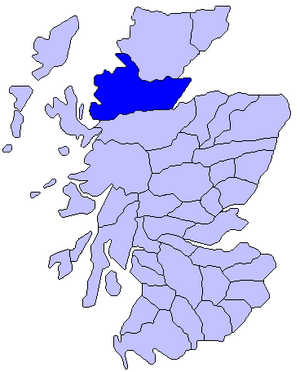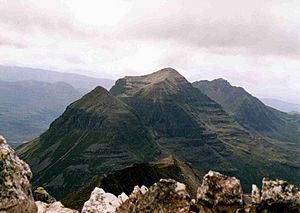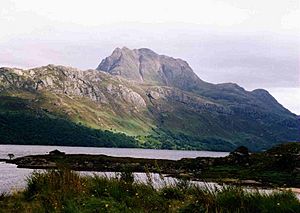Ross facts for kids
Ross (called Ros in Scottish Gaelic) is a special area in Scotland. It used to be a very old region ruled by an Earl and was also a county.
The name Ross might come from a Gaelic word meaning "headland," which could be talking about the Black Isle. Another idea is that it comes from an Old Norse word, Hrossey, meaning "horse island." This is because the area was once part of the Norwegian earldom of Orkney. Ross is a very old region that existed even before the Mormaerdom of Ross.
Contents
Ross's Past: A Look Back
Scientists have found signs that people lived on the coast of Wester Ross a very long time ago. These were Mesolithic hunter-gatherers, who hunted animals and gathered plants for food.
The Romans probably never stayed in this area for long. In Roman times, Picts lived here. In the 500s and 600s, followers of Saint Columba helped the Picts become Christians.
For the next 300 years, Viking raiders from Norway often attacked the people. You can still see signs of them in place names like Dingwall and Tain. At that time, Ross was part of a much larger area called Moray.
William, the 4th Earl of Ross, fought with his clan at the Battle of Bannockburn in 1314. Later, in 1412, the castle of Dingwall was captured. This happened after a big fight at Harlaw. The earldom of Ross went back to the king in 1424.
However, King James I soon gave it back to the family. But because of a betrayal by John Macdonald, the earldom returned to the crown in 1476. Five years later, King James III gave it to his second son, James Stewart.
By the 1500s, different clans lived in the area. The Rosses lived in Easter Ross. The Munros lived around Ben Wyvis, including Dingwall. The Macleods lived in Lewis and near Loch Maree. The Macdonalds lived in Coigach, and the Mackenzies lived in the rest of the area.
The county of Ross was officially formed in 1661. Another county, Cromarty, was formed later. Both were joined together in 1889 to make the county we know today.
There were only a few big battles in the county. One was at Invercarron in 1650, where Montrose was defeated. Another was at Glenshiel in 1719. Here, Jacobites (supporters of the Stuart kings) and Spanish soldiers were defeated by General Joseph Wightman.
Ross's Amazing Geography
Ross is located south of Sutherland and the Dornoch Firth. It is west of the North Sea and the Moray Firth. To the north, it has the Beauly Firth and Inverness-shire. To the east, it borders The Minch.
There are also several small islands off the west coast of Ross. These include:
- Gillean (which has a lighthouse)
- Crowlin Islands
- Eilean Horrisdale
- Isle of Ewe
- Isle Martin
- Tanera More (part of the Summer Isles)
The mainland part of Ross is about 1,572,332 acres big.
On the east side, facing the North Sea, are major sea inlets called firths. These include the Beauly Firth and the Moray Firth. They separate the Black Isle from Inverness-shire. The Cromarty Firth borders Easter Ross and the Black Isle. The Dornoch Firth separates north-east Ross from Sutherland.
On the west coast, facing the Atlantic Ocean, there are many sea lochs and bays. These are long, narrow inlets of the sea. From south to north, some main ones are Loch Duich, Loch Alsh, Loch Carron, Loch Torridon, Gair Loch, Loch Ewe, Gruinard Bay, and Loch Broom. The west coast is nearly 311 miles long.
Important capes (points of land sticking into the sea) include Tarbat Ness on the east coast. On the west, there are Coigach, Greenstone Point, and Rubha Reidh.
Most of the southern border with Inverness-shire is made of tall mountains. Many of these are Munros, which are Scottish mountains over 3,000 feet high. Some examples are An Riabhachan (3,704 feet), Sgurr na Lapaich (3,773 feet), and Carn Eige (3,881 feet).
North of Glen Torridon are other large mountains like Liathach (3,455 feet), Beinn Eighe (3,313 feet), and Beinn Alligin (3,235 feet). On the shore of Loch Maree, you can see Slioch (3,219 feet). The Fannich group of mountains has six Munros. The huge Ben Wyvis (3,428 feet) stands out in the north-east.
The longest river in Ross is the River Orrin. It flows north-east for about 26 miles before joining the River Conon. The River Blackwater flows southeast for 18 miles to join the Conon. The Falls of Glomach are amazing waterfalls in the southwest. The Droma River forms the Falls of Measach near Corrieshalloch Gorge.
Ross has many freshwater lochs (lakes). The biggest is Loch Maree. Lochan Fada is a long loch about 1,000 feet above sea level. Other lochs include Fionn Loch, known for its herons, and Loch Luichart. Loch Fannich is surrounded by mountains. The narrow Lochs Monar and Mullardoch are on the border with Inverness-shire.
The main straths (valleys) in Ross run from the center towards the east. These include Strathconon, Strathbran, and Strathpeffer. In the far south, Glen Shiel runs between five mountains called the Five Sisters of Kintail. The A87 road goes through this glen. Further north are Glen Elchaig, Glen Carron, and Glen Torridon. A railway line runs through Glen Carron to Kyle of Lochalsh.
Weather, Farms, and Animals
The west coast of Ross gets a lot of rain. It averages about 50 inches per year at Loch Broom. The east coast is much drier, with only about 27 inches per year. Autumn and winter are the wettest seasons.
The most fertile land is on the east coast, especially in Easter Ross and the Black Isle. The soil here can be sandy or rich and deep. Farmers grow oats, barley, and wheat. Turnips and potatoes are also important crops.
Higher up, there is good pasture land for animals. Many sheep are raised, especially the blackfaced breed. Most horses are used for farm work. There are also large herds of cattle, mainly native Highland cows. Many of these cows are sent to the London market. Pigs are also raised, often by crofters (small-scale farmers).
In 1911, about 800,000 acres were used for deer forests. This was more than any other county in Scotland. Some of the largest were Achnashellach and Fannich. The name "Ross" might even come from an old Irish word for "wood." There used to be many native woodlands with pine, oak, ash, and alder trees.
The animals in Ross are interesting. Red and roe deer are common. Foxes and alpine hares are also often seen. Sometimes, badgers and wild cats are found. There are many game birds. Birds of prey like the golden eagle and osprey live here. All kinds of waterfowl visit the sea lochs. Many rivers and lochs have lots of salmon and trout. You can even find pearl mussels in the Conon River.
Other Ways People Work in Ross
Tourism is a very important industry in Ross. More than 20% of the people who work here are in hotels, restaurants, and shops. This is second only to public services. About 5% of workers are in farming, forestry, and fishing, which used to be the main jobs. The oil industry, which grew a lot in the 1970s, is now smaller but still provides many jobs.
The Glen Ord and Glenmorangie distilleries are famous for making whisky.
A railway line, the Far North Line, comes into Ross from Inverness. It goes north through Dingwall and Tain. From there, it continues north to Thurso and Wick. Another railway line, the Kyle of Lochalsh Line, goes west from Dingwall to the Kyle of Lochalsh.
Old Buildings and Sites
The main old things you can find in Ross are stone circles, cairns (stone mounds), and forts. These are mostly in the eastern part of the area.
A special kind of fort, called a vitrified fort, is on Knockfarrel hill. There is also a round fort near Lochcarron. You can see beautiful carved stones, especially those that are said to mark the graves of three sons of a Danish king. They were shipwrecked off the coast of Nigg.
The biggest and most beautiful of these crosses is the Clach a' Charraidh, or Stone of Lamentation, at Shandwick. It is about 10 feet (3 meters) tall. It shows pictures of Saint Andrew being martyred and also has an elephant and a dog. It broke in 1847 but has been put back together.
Another cross in Nigg churchyard shows two figures praying. A dove is between them, and two dogs are below. This cross was also damaged but has been repaired. A third stone used to be at Hilton of Cadboll but was moved to Invergordon Castle for safety.
Some old castles in Ross include Lochslin Castle, which might be from the 1200s. It is in ruins but still has two square towers. Balone Castle was once a strong place for the Earls of Ross. You can also see the remains of Dingwall Castle, which was their first home. Eilean Donan Castle in Loch Alsh was blown up by British warships in 1719 during a Jacobite uprising.
See also
 In Spanish: Ross para niños
In Spanish: Ross para niños




